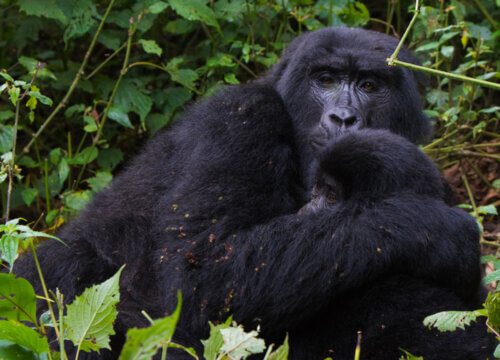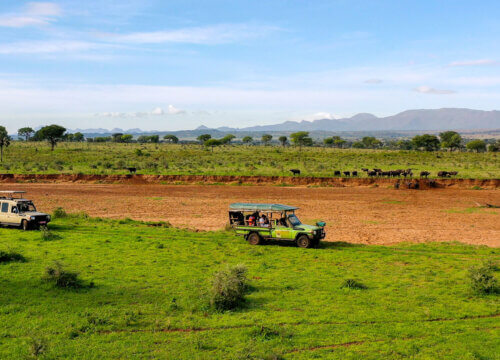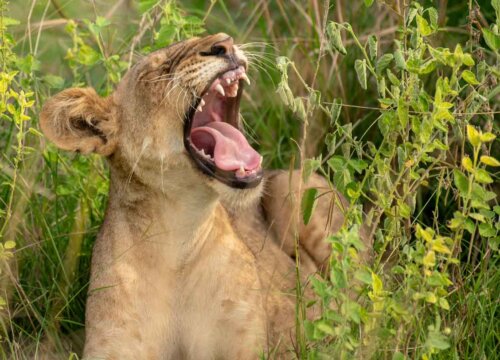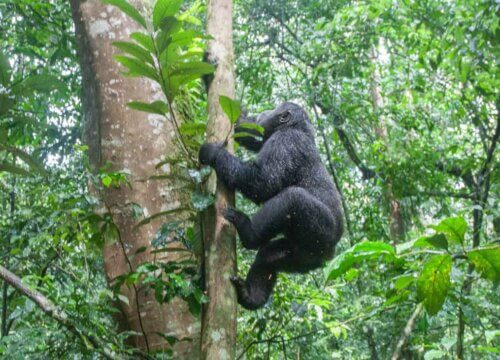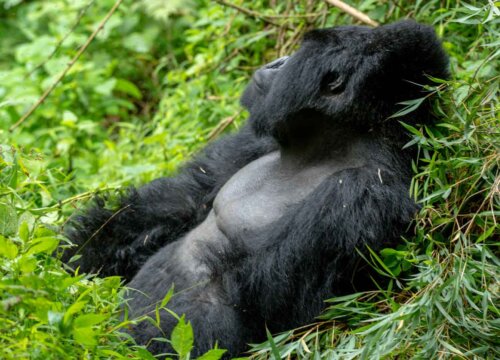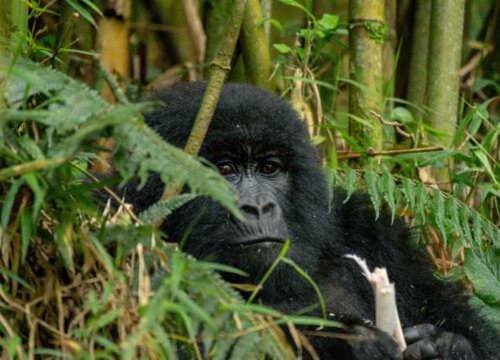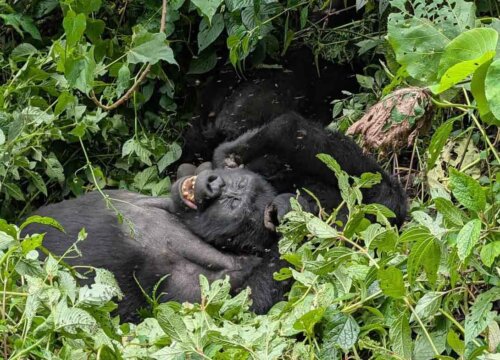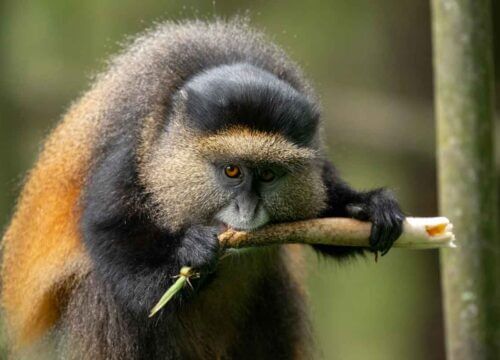10 Facts about mountain gorillas
10 Facts about mountain gorillas
Mountain gorillas (Gorilla beringei beringei) are a critically endangered species, primarily found in the dense forests of the Virunga Mountains, which span Rwanda, Uganda, and the Democratic Republic of Congo, Below are the 10 Facts about mountain gorillas
Mountain Gorillas are endangered but the only species with an increasing population
Mountain gorillas are critically endangered and face significant threats to their survival. The population of mountain gorillas has been on the decline due to habitat loss, poaching, disease, and human wildlife conflict. However, conservation programs over the past few decades have led to a dramatic recovery. In 2008, the International Union for Conservation of Nature (IUCN) reclassified the mountain gorilla from “Critically Endangered” to “Endangered,” reflecting the positive impact of these efforts. These programs include anti-poaching patrols, habitat restoration, and ecotourism, which has helped raise awareness and generate funds for conservation. In addition, local communities play a crucial role in protecting gorillas by benefiting from tourism and engaging in conservation education. As of 2020, the mountain gorilla population in the wild has grown to over 1,000 individuals, a significant achievement for wildlife conservation.
Mountain Gorillas have a unique habitat in the Virunga Mountains
Mountain gorillas inhabit in the dense forests of the Virunga Mountains, a volcanic range in central Africa, which spans the borders of Rwanda, Uganda, and the Democratic Republic of Congo (DRC). These mountains provide a unique environment that is home to various plant and animal species. The gorillas live at high altitudes between 2,200 and 4,300 meters (7,200 to 14,100 feet) above sea level. The cool, misty climate and dense vegetation of these forests offer both shelter and food, with vegetation such as bamboo, wild celery, and tree leaves forming the mountain gorillas’ primary diet. Their habitat is threatened by deforestation and human encroachment, which makes conservation of this region even more critical.
Mountain Gorillas live in a Social structure and family groups
Mountain gorillas live in social groups called troops, typically consisting of a dominant silverback, several females, and their offspring. The silverback is the leader of the group and plays a crucial role in protecting and guiding the family. He is typically the largest male in the group, with silver hair on his back, which gives him the “silverback” moniker. Females choose their mate based on the silverback’s size, strength, and ability to protect the family. These family units exhibit strong bonds, with mothers caring for their young for up to three years, teaching them how to find food and survive in the wild. Although groups may have multiple adult females, the silverback often maintains exclusive mating rights with them.
Mountain Gorillas Communicate through sounds and gestures
Mountain gorillas are known for their rich and diverse communication methods. They use a variety of vocalizations, body language, and facial expressions to interact with one another. These sounds can include grunts, roars, and barks, which communicate everything from contentment to alarm. For example, a gorilla may make a low growl or hoot when expressing displeasure or during a display of dominance. When content they might make soft grumbling noises. In addition to vocalizations, mountain gorillas also use gestures and body movements such as chest beating to show strength or dominance. Their facial expressions including baring their teeth or raising their eyebrows also play a critical role in nonverbal communication.
Diet and Feeding Habits of Mountain Gorillas
Mountain gorillas are primarily herbivores and consume a varied diet that includes leaves, stems, fruit, flowers, and bamboo. A typical gorilla will spend several hours a day foraging for food, which makes up the majority of their activity. They are known to be selective feeders, picking the most nutritious parts of plants. One of their favorites is bamboo which grows in abundance in their high altitude habitat. Gorillas typically eat between 20 and 30 kilograms (44 to 66 pounds) of vegetation daily to sustain their large size. Their digestive system is designed to handle large quantities of plant matter and they often spend time chewing for extended periods to fully break down tough materials.
What are the physical characteristics and Size of Mountain Gorillas?
Mountain gorillas are the largest of all gorilla subspecies with males typically weighing between 140 and 200 kilograms (310 to 440 pounds) and females much smaller at around 90 kilograms (200 pounds). Adult males or silverbacks can grow up to 1.8 meters (5.9 feet) tall when standing upright while females reach about 1.4 meters (4.6 feet). These powerful primates are characterized by their robust bodies, broad chests, and long muscular arms. The silverback’s silver hair is a distinctive feature that signifies maturity. Mountain gorillas are not as tall as some other primates but their size is compensated by their immense strength allowing them to move through dense forest with ease.
What is the reproductive behavior and lifespan of Mountain Gorillas?
Mountain gorillas have a relatively slow reproductive rate. Females typically give birth for the first time at around 10 years of age and they usually have one baby at a time, after a gestation period of about 8.5 months. A mother will care for her infant for up to three years, during which time the baby learns essential survival skills, including how to find food and communicate. Infant gorillas are born weighing about 1.5 kilograms (3.3 pounds) and are dependent on their mothers for protection and nourishment. The lifespan of a mountain gorilla in the wild can exceed 35 years although many do not live that long due to threats like disease or human activities. In captivity, they can live up to 50 years.
Human Interaction and Ecotourism
One of the most significant factors in mountain gorilla conservation has been the rise of ecotourism. Gorilla trekking is a popular activity particularly in Rwanda, Uganda, and the DRC. Tourists pay to visit gorillas in their natural habitat which provides vital revenue for local communities and conservation initiatives. This approach has helped fund the protection of the gorillas and their environment. By offering a direct economic incentive for conservation, ecotourism has become a sustainable means of ensuring the survival of mountain gorillas. Additionally, gorilla trekking allows people to form a personal connection with these endangered animals fostering greater awareness and support for conservation efforts.
What are the threats to Mountain Gorillas?
Mountain gorillas are highly susceptible to diseases especially those transmitted by humans. Human respiratory diseases like influenza and the common cold pose significant threats to gorilla populations as they can cause severe illness or death in the primates. In response to this risk, strict guidelines are followed during gorilla trekking including maintaining a safe distance of at least 7 meters (23 feet) from the animals and ensuring that tourists are in good health. Veterinary teams also monitor the health of gorillas providing care when necessary and working to prevent the spread of disease. The spread of disease is one of the primary challenges to maintaining a healthy and growing gorilla population.
What is the rate of mountain gorilla population recovery?
The mountain gorilla population has been steadily recovering in recent years thanks to ongoing conservation efforts. As of the last count in 2020 the population exceeded 1,000 individuals a remarkable increase from the low point of fewer than 250 individuals in the 1980s. This recovery has been attributed to several key factors including intensive anti-poaching measures, habitat protection, and effective management of human wildlife interactions. Researchers and conservationists are hopeful that with continued efforts the mountain gorilla population will stabilize and possibly continue to grow. This recovery is a testament to the effectiveness of focused conservation strategies and the resilience of this extraordinary species.
Explorer More Safaris
- 14-Days Uganda Safari Gorilla Chimpanzees and Wildlife
- 12 Days Gorillas and Chimpanzees Wildlife Safari
- 10 days best of uganda primates & wildlife safari
- 6 Days Gorillas and Chimpanzee Trekking Safari
- 3 Day Bwindi Gorilla Trekking Safari
- 4 Day Uganda Gorilla Trekking and Wildlife Safari
- 4 Days Gorilla Trekking and Adventure Safari
- 5 Days Uganda Gorillas and Chimpanzee Tracking Safari
- 4-Day Rwanda Gorilla Trekking and Golden Monkey Tracking Safari
- 5 Day Gorilla Habituation and Chimp Trekking
- 4-Day Uganda & Rwanda Gorilla Trekking Tour
- 3 Days Bwindi Gorilla Trekking Ugnada from Rwanda
- 10 Days Uganda Primates and Game Safari

